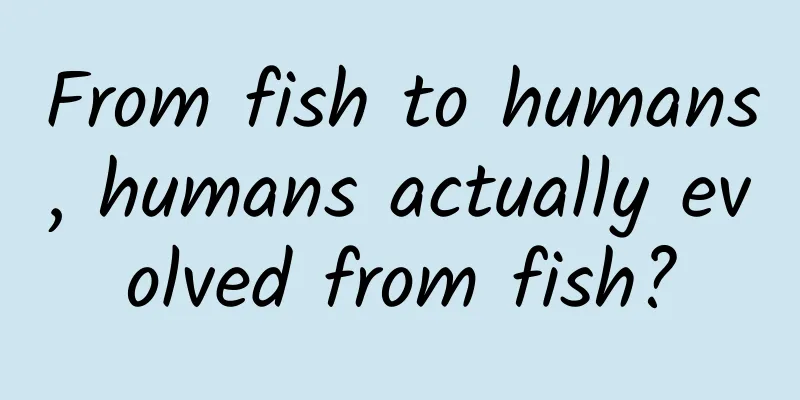From fish to humans, humans actually evolved from fish?

|
Recently, the Chinese Academy of Sciences held a press conference on the major achievements of the "From Fish to Man" research. The reason for this press conference is that Zhu Min's team discovered the "Chongqing Special Buried Fossil Repository" and "Guizhou Shiqian Fossil Repository" in the strata of the early Silurian period in Chongqing and Guizhou, which are about 440 million years old. This filled the "major stubborn gap in the history of paleontology" in the global early Silurian jawed fossil record, and provided definite evidence for the rise and earliest radiation differentiation of jawed jaws for the first time. The emergence and rise of jawed fish have always been one of the most critical leaps in the history of vertebrate evolution from fish to humans. However, due to the lack of fossil evidence, the origin and rise of jawed fish have always been shrouded in mystery. For the first 30 million years of their appearance, jawed fish have been a "ghost lineage". The major discovery of Academician Zhu Min's team is expected to reveal these mysteries. So what does this study say? Let’s talk about it today. 01. Are humans and fish similar? Hahaha, it's not just fish that kowtow to humans, dinosaurs also have to stand up and kowtow, giant pandas, Siberian tigers, and great white sharks hold hands to pay tribute to their ancestors. For this study, if you want to find something similar to us humans, it's probably: 1. Spine (this fish is a vertebrate) 2. Upper and lower jaws (upper jaw and lower jaw, also the main discovery of this time, with jaws) 3. Neck (Xiushan fish is a transitional type, with a crack that allows the head to move, and this will later become the neck of vertebrates). Don't even think about anything else. This was 440 million years ago, and we mammals occupied an ecological niche. During this period, we experienced: fish walked on land, and reptiles ruled the earth for 400 million years until the end of the Cretaceous period, which was 60 million years ago. At that time, our human ancestors were probably only the size of mice and looked quite similar to squirrels. So if you want to find traces of modern humans, it might be easier to find them. This discovery, which fills a gap in evolutionary history, is certainly worthy of four Nature articles and a cover. 02. What did this study find? So what did this study find? Simply put, it found evidence of the origin of jawed creatures. What are jawed animals? The common understanding is that the mouth is divided into two parts , the upper jaw and the lower jaw (some people call it the upper jaw and the lower jaw, anyway, they correspond, just be happy). This structure is called the jaw in academic terms. Think about it, don’t many creatures in nature have this kind of mouth structure? Yes, that's right. Among the common vertebrates we see, 99.8% belong to this category, that is, jawed animals. ps: Jaw refers to the bones and muscle tissue that make up the upper and lower parts of the mouth. The upper part is called the maxilla, and the lower part is called the mandible. However, because muscle tissue is too difficult to fossilize for older animals, more attention is generally paid to fossils left by skeletal structures. The upper and lower jaws are called whatever you like. They were originally called maxillary and lower jaws. Humans call the lower jaw the chin, so it seems to be OK to call the upper jaw the chin. Since it can be so widely distributed in vertebrates, it must have a very early origin. Before this, scientists had discovered two types of organisms. 1. Jawless animals. These are the oldest species of animals, which have no upper or lower jaws. 2. Already fully developed upper and lower jaws. This is the type of almost all vertebrates that have followed, and they basically have this type of upper and lower jaws. 03. What is so special about the miracle Xiushan fish? The discovery of the miracle Xiushan fish allowed scientists to find this transitional type. The following figure is a schematic diagram of the transitional type we need to find (note that the yellow thing in the figure is not the jaw, but the skull) This time, scientists found this rare transitional stage in Xiushan, Chongqing. This is where the discovery was made, Xiushan, Chongqing. Figure C is a schematic diagram of the local geological environment, and Figure D is an imagined process of burying these fish. In this place, a complete fish was found, which is the miracle Xiushan fish. As shown in the following picture, the left side is the fossil and the right side is the structural analysis. This type of fish is very different from previous fish. It has an additional structure, which is the jaw. But I really admire the geologists who can see this. Of course, they used a lot of advanced tools to interpret it, such as high-precision CT scanning, fine three-dimensional reconstruction, scanning electron microscopy element analysis, full-optical imaging, multivariate statistical analysis and other means to finally discover these truths. As shown in the picture below, this is the process of MicroCT scanning gradually scanning and discovering the structure. When restored, it looks like this. Let's review this process. At the beginning, the mouth had no jaw, only a hard skull on the head. Then two bones, the upper and lower jaws, grew, allowing the jaws to open and close better to chew food. In addition, this Xiushan miracle fish is very special in that its neck is in a transitional stage. Mature jawed mammals have movable cervical joints. Think about it, you can turn your head at any time, right? This is the cervical joint at work. Completely jawless fish, on the other hand, cannot move. For example, armored fish cannot move their heads, so if they want to turn their heads and adjust their direction, they have to move almost their entire upper body. But the miracle Xiushan fish is somewhere in between. It can't move completely, but it's not completely immobile. Instead, there is a horizontal crack in the middle of the head carapace, which can play the role of a neck joint to a certain extent. In this way, its head can move independently of the body, making hunting easier. The bone piece in front of the crack on the top of the Xiushan fish's head in the picture corresponds to the occipital bone of humans. Sometimes I think about how it took our ancestors tens of millions of years to successfully grow a neck. This process required the helmet to crack, just to allow the head to move, so that it could move up and down to breathe and hunt. But today, we humans have been staring at the screen at the same angle, making a retro move. This is very similar to the jawless animals who cannot move their heads. As a result, they have developed cervical spondylosis. It's really sad. This kind of discovery of super-distant times is very dependent on fossils, so every time a fossil group is discovered, it is definitely a huge boost, and this thing is still hard to come by. This discovery corresponds to this time period, and in many cases it is the only one in the world. The Chongqing Biota is another major discovery following the Chengjiang Biota and the Jehol Biota. It is estimated that many more major discoveries will be made in the future. By the way, paleontology belongs to the field of geology. If you are interested, you can try your eyesight. Of course, there are actually many more discovered in this place, as shown in the picture below. Test your eyesight to see if you can recognize the animal from the fossil on the left and match it with the picture on the right? |
>>: Can the ears affect the taste nerves, allowing people to hear the taste? How is this possible?
Recommend
China Passenger Car Association: Battery demand for pure electric passenger cars will increase by 15% in 2024, and battery demand for plug-in hybrid passenger cars will surge by 86%
Cui Dongshu, secretary general of the China Passe...
You may be eating these five types of foods that cause inflammation every day! Reminder →
Many diseases that plague the human body All have...
Apple, Microsoft, and Google: The Harmony of the Technology Industry
[[137102]] Microsoft Build, Google I/O, and Apple...
iPhone 6S battery has shrunk! What about battery life?
At the press conference, Apple did not announce t...
How to improve user registration conversion and user activation
User registration conversion and user activation ...
Aston Martin Vantage AMR limited to 300 units
Aston Martin has recently released the official p...
OPPO Pad Air review: A cost-effective beast that emerged amid the trend of large-screen mobile phones and thin and light PCs
In the tablet computer field, whether it is Apple...
Event operation and promotion: How to design a good lottery event?
This article analyzes and discusses how to design...
The latest research: Gaining weight really makes people stupid!
Is being fat a disease? Yes, and it is the “root ...
Amazon: AMD CPU shipments account for 84.18% in February 2025, far ahead of Intel
According to the latest data, AMD accounted for 8...
The death of female mathematician Hypatia shows the contest between science and ignorance, light and darkness in history
In the thousands of years of human civilization, ...
Catching up with Ferrari, BAIC New Energy ARCFOX-7 has a peak torque of over 1,000
According to official news from BAIC New Energy, ...
Cells are like "series circuits"! It is the "electrical monster" in the Amazon water
Electric eels live mainly in turbid, circling wat...
China Automobile Dealers Association: Analysis of vehicle data for the first week of September 2023
In the first week of September 2023, there were 1...
How to build a user operation system: a detailed analysis using Keep as an example
As a leader in online fitness course apps, Keep h...









